Sony A7R IV vs A7R III: all the key differences between Sony's Alpha models
The sensor's just the start

Just as everyone was expecting Sony to finally unleash the Alpha A7S III or possibly even an Alpha A7000, the Japanese electronics giant decided the time was ripe for the Alpha A7R Mark IV – and it’s quite a step up on the previous A7R III, which has been catering for all manner of pixel-hungry applications since its 2017 launch.
So what exactly did Sony change for this new model? The sensor is the big difference, but there’s far more to it than that, with improvements both big and small. Here, we run through all the key differences between the two.
Sony A7R IV vs A7R III: new sensor

This is the biggie: a 61MP back-illuminated, full-frame sensor, the first of its kind to feature inside a mirrorless camera like this one.
This is a considerable jump up from the 42.4MP sensor inside the A7R III, and it also leapfrogs a number of medium-format models for pixels too, such as the Fujifilm GFX 50R and Hasselblad X1D II 50c – indeed, one of Sony's claims for the new camera is that it delivers medium format-level image quality.
Sony claims this offers 15EV of dynamic range at lower sensitivities, which is certainly impressive, although it made the same claims for the A7R III. Once again, this works with a BIONZ X processing engine, which appears to be unchanged.
Sony A7R IV vs A7R III: EVF

The 3.69 million-dot viewfinder inside the A7R III was pretty well specced at the time of the camera’s release, and on a par for resolution with the likes of the Fujifilm X-T3, Nikon Z7 and the Canon EOS R, but things have moved on here and we’re now seeing 5.76 million-dot viewfinders inside some models, like the Panasonic S1R and Fujifilm GFX100.
So it’s great to see the A7R IV has matched this, with its EVF also boasting an OLED panel with 5.76 million dots (Ultra XGA), representing a 1.6x boost.
Get daily insight, inspiration and deals in your inbox
Get the hottest deals available in your inbox plus news, reviews, opinion, analysis and more from the TechRadar team.
This is the highest resolution viewfinder we’ve seen yet on a Sony Alpha model, and it can be set to either 60fps or 100/120fps refresh rates. Many cheaper cameras now offer the latter, so this is very much the minimum we expect here. The magnification and eyepoint have remained the same as before, at 0.78x and 23mm respectively.
Sony A7R IV vs A7R III: AF system
Autofocus is one area where pretty much every manufacturer is trying to outdo its rivals right now, and the A7R IV arrives with a number of changes.
The highlight is that there are now far more AF points than before. The system is once again a Fast Hybrid AF system that fuses phase- and contrast-detect AF, but while the A7R III offers 399 phase-detect and 425-point contrast-detect AF points, the A7R IV boasts 567 phase-detect AF points (and the same number of contrast-detect AF points).
These extra points means that frame coverage has also risen from around 68% on the A7R III to 74% on the newer model.
Sony A7R IV vs A7R III: AI-based subject tracking

The A7R IV becomes the latest camera to arrive with claims of AI helping its autofocus system recognize different subjects, from humans to animals. Specifically this is behind the Real-time Eye AF option, which works on both types of subjects.
The fact that there are so many more phase-detect AF pixels, together with refinements to the tracking algorithms, are also behind claims of better tracking performance than before.
The A7R III does, however, benefit from enhanced Real-time Eye AF performance for humans and animals in the most recent version 3.0 firmware.
Sony A7R IV vs A7R III: video
While there haven’t been any significant changes to video functionality, things aren't quite the same here.
Just like the A7R III, the A7R IV records 4K footage using the full width of its sensor, but when capturing footage in the Super 35mm crop mode the higher-resolution sensor means 6K footage is initially sampled, rather than 5K footage as on the A7R III. In both cases this is still output at 4K, but potentially it means the A7R IV may deliver better-quality results.
Something that's probably easier to appreciate is the fact that Real-time Eye AF is now available for video recording on the A7R IV, rather than just for stills, as on the A7R III. Touch Tracking autofocus is also a new addition here, which lets you key the subject on the screen so that the camera can track this.
Sony A7R IV vs A7R III: buffer and continuous shooting
Sony has beefed up the A7R IV's buffer by a factor of 1.5x over the A7R II, and this allows consecutive shooting at the maximum 10fps rate for 68 frames (almost seven seconds), with autofocus and auto-exposure working throughout.
If you want live view, the camera will oblige at 8fps – and if you want uncompressed raw files, then this burst depth is knocked down to 30 frames from 68.
The A7R III also offers 10fps burst shooting with autofocus and auto exposure maintained, and does so for up to 76fps. But it’s dealing with far less information, which is what makes the Mark IV so impressive here.
Sony A7R IV vs A7R III: crop mode
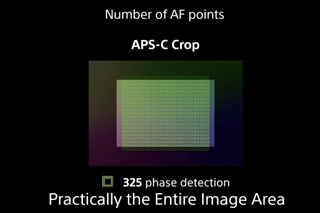
Pop an APS-C lens on the A7R IV, or simply select this crop mode through the menu, and you can continue to capture images at 26.2MP. That’s a consequence of the more densely populated sensor, and is pretty impressive, although the A7R III’s 18MP equivalent option isn’t significantly behind this.
This is great if you need to give your lenses extra reach, and you get 325 phase-detect AF points pretty much filling this whole area on the A7R Mark IV too. Another perk when using this mode on the A7R IV is that the buffer is around three times as long when shooting continuously than it is when using the camera in its native full-frame setting.
Sony A7R IV vs A7R III: Pixel Shift Multi Shooting mode
The principle of capturing and combining a number of images to produce a single file with more detail has been a feature of many recent cameras, and this is something the previous A7R III offered.
Whereas the A7R III captures four images at 42.4MP before using this 169MP data to produce a single file with higher detail – albeit still at 42MP – the A7R IV not only uses a higher-resolution sensor, but captures up to 16 images, shifting the sensor between a half pixel or a full pixel between each frame.
This means it amasses up to a staggering 963.2MP of information when set to its 16-shot mode – although, as with the A7R III, this doesn't mean you end up with images at this resolution.
So what happens? You need to use Sony's Imaging Edge software here, which produces a file with a mighty impressive 240.8MP. So, not quite as convenient as cameras that stitch it all together in-camera, but no doubt something you’re likely to call upon if you really need that detail. And you can see all this in action in the above video.
Sony A7R IV vs A7R III: LCD screen
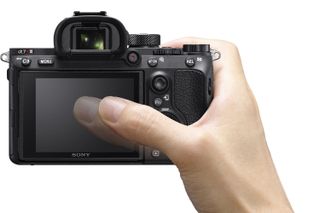
With the same 3-inch dimensions, same 1.44 million dots to play with and the same degree of physical adjustment relative to the body, it seems Sony has left the LCD screen alone for the A7R Mark IV. Yet, it claims to have improved the speed of response by a factor of 1.5x when touched, such as when setting the focusing point.
Sony A7R IV vs A7R III: grip and ergonomics
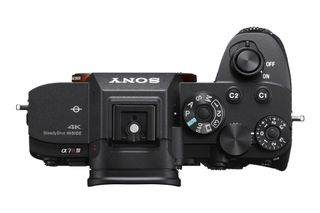
No doubt in response to user feedback, the grip has been revamped for this new model for comfort and to better support longer lenses.
The Multi Selector – or AF joystick – also adopts a new design, and is claimed to gave better response, while the AF-On button has also had a slight adjustment to make it easier to use.
The camera overall is a touch larger and heavier before, but the difference here is so slight that you probably won’t even notice it.
Sony A7R IV vs A7R III: exposure mode dial
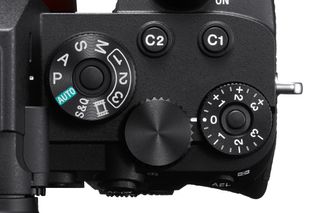
Exposure compensation dials are often perched perilously close to the sides of a camera’s top plates, and as a consequence can be easily be knocked out of position. Not on the A7R IV, however, which follows many other models in having a locking button in its center to keep it where it is, something that's lacking on the A7R III.
Sony A7R IV vs A7R III: dust and moisture protection

The A7R III promises environmental protection, but Sony has also given the A7R IV slightly better sealing against dust and inclement weather.
This is said to have been applied at all body seams, which includes new gaskets at the memory card and battery compartments, as well as better doors to the ports. The firmness of the lens mount is also said to have been improved.
Sony makes it clear the camera is still not guaranteed to be 100% protected against dust and moisture, but it's welcome to see this small improvement all the same.
Sony A7R IV vs A7R III: shutter unit
One issue with high-resolution cameras such as the A7R IV is that vibrations can rob images of fine detail. Even a small vibration at the time of capture can lead to less-than-perfect results, so it’s encouraging to see that Sony has redesigned the shutter unit to better suppress these.
This is said to be on top of a tweak to the image stabilization system to achieve the same goal, although the 5.5-stop advantage of the system is the same as before. Once again, shutter count is rated at 500,000 actuations, which is very respectable.
Sony A7R IV vs A7R III: connectivity options
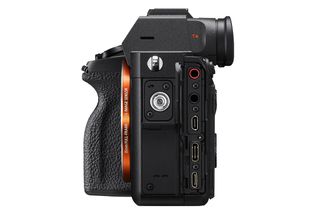
Wi-Fi, NFC and Bluetooth all continue to the new camera, as do USB-C, HDMI, microphone and headphone ports, but there have been changes.
The A7R IV still works on Bluetooth 4.1 2.4Ghz as the previous model, although Wi-Fi is now offered on both 2.4GHz band/5GHz bands. This should allow for speedier and more stable connections than the A7R III, which only offered 2.4GHz.
A smaller change is that tethered shooting can now work across a Wi-Fi connection, rather than a physical cable. This is the first time we’ve seen this on a Sony camera, although it’s something we’ll no doubt see in future A7- and A9-series models.
The camera also now sports a USB 3.2 Gen 1 connection, which is said to allow for data transfer at nearly twice the speed of the A7R III when using Sony’s Imaging Edge software.
Sony A7R IV vs A7R III: memory card support
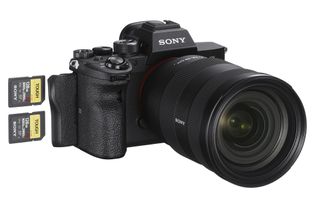
While the A7R III only has support for UHS-II memory cards in its primary slot, the A7R IV is blessed with UHS-I and UHS-II support in both, which means you should see the same performance from the two.
Sony has also dropped the switch that needed to be pulled down before the door is opened on the A7R III for the new model, and it also appears to have dropped support for its proprietary MemoryStick card format, possibly because of the change to UHS-II in both ports, but also likely because nobody has used a MemoryStick card since 2004.
Sony A7R IV vs A7R III: Multi interface shoe
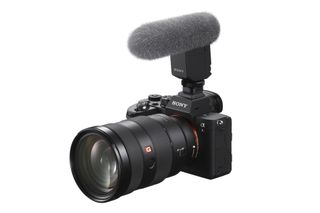
The hot shoe on the top of the camera appears the same as before, but Sony has revised its design to now include a digital audio interface.
Christened MI Shoe, this lets you hook up a microphone without any cables running into the side of the body. One option here is the ECM-B1M Shotgun Microphone that was launched at the same time as the camera.
Sony A7R IV vs A7R III: battery life
While the A7R IV uses the same NP-FZ100 battery as its predecessor, battery life when using the LCD screen has marginally improved.
You can now rattle off 670 frames per full charge, rather than 650 frames as on the A7R III, although in reality you’ll achieve more than this because of exactly how CIPA figures are determined.
Using the EVF? The 530 figure is the same as before, which is better than many other cameras but still well behind what you’d expect on an equivalent DSLR. Still, if you need extra juice, you can always grab the new VG-C4EM battery grip, which will accept two of these batteries.
